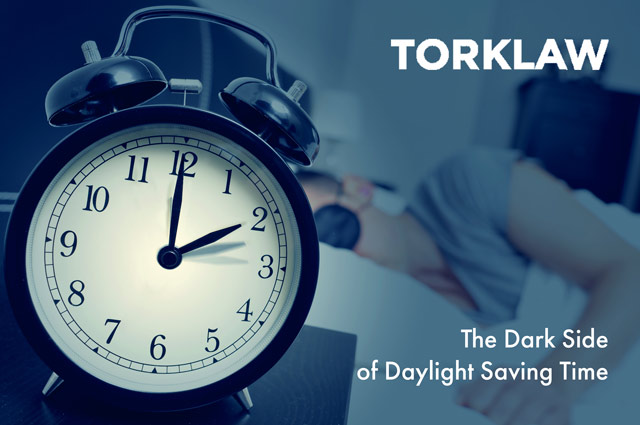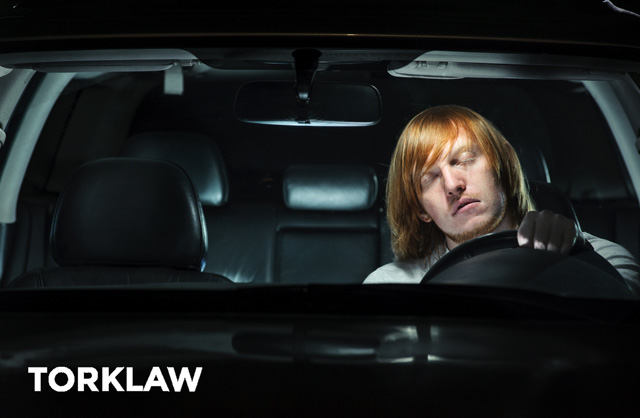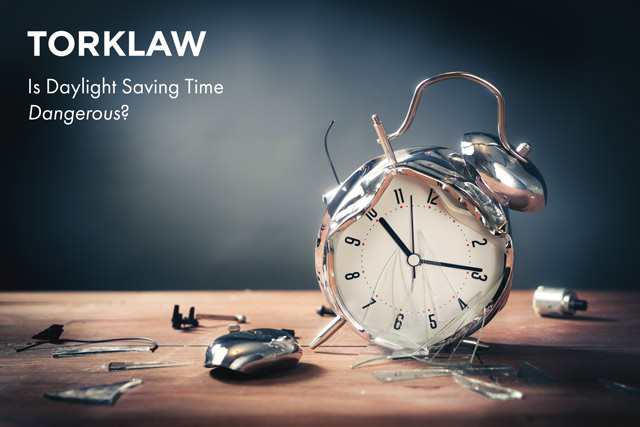Most of us in the U.S. will set our clocks forward this weekend – and increase our risk of dying in a car accident by six percent, according to a recent study.
The findings come as a majority of U.S. states are considering ditching the switch entirely.
Last March, we warned readers about “The Dark Side of Daylight Saving Time” (see below), which referenced research showing spikes in heart failure, motor vehicle and pedestrian accidents, work-related accidents, and lost productivity in the week following the “Spring forward” time change.
A new study published on January 30 in the journal Current Biology seems to prove the point.
The Effects of Daylight Saving Time on Car Accident Risk
The study was the most comprehensive assessment of the correlation between Daylight Saving Time and fatal motor vehicle accidents to date. Researchers looked at 732,835 accidents listed in the Fatality Analysis Reporting System between 1996 and 2017. They excluded states that do not consistently observe seasonal time changes, such as Hawaii, the part of Arizona outside the Navajo Nation, and the U.S. territories of American Samoa, Guam, Puerto Rico and the Virgin Islands.
More evidence: In 2007 the Energy Policy Act moved the start of Daylight Saving Time from the first Sunday in April to the second Sunday of March. The study showed that before 2007, the risk of fatal crashes began to increase in April. After 2007, the increase moved to March.
In the 22 years the study analyzed, the study estimated 627 people died in car accidents associated with the shift to Daylight Saving Time. They cited causes including sleep deprivation and driving in the dark.
When we “Fall back,” the number of accidents doesn’t change, but there is a visible shift in the time of day more accidents occur. When we revert to Standard Time, the morning accidents decline, because it’s lighter outside. But they spike in the evening when darkness falls earlier.
Because the data did not include non-fatal car accidents, the study’s authors believe the results underestimate the true risks of Daylight Saving Time. In fact, the results support abolishing seasonal time changes altogether.

So Why Don’t We Get Rid of Daylight Saving Time?
40 states have introduced legislation in 2019 to do away with the seasonal time changes. However, because there have been multiple bills in some states, there are almost 80 different pieces of legislation, each one a bit different.
Some states have competing bills proposing opposite solutions. Some legislation is contingent on the actions of neighboring states, which may be proposing an opposite or otherwise incompatible solution. For example:
- 23 states want to make DST permanent – so when they set their clocks ahead in the spring, they’d never set them back. They are: Alabama, Alaska, Arkansas, California, Florida, Iowa, Maine, Minnesota, Mississippi, Missouri, Montana, Nevada, New Jersey, New Mexico, North Carolina, Oregon, South Carolina, Tennessee, Utah, Vermont, Washington, West Virginia, and Wyoming.
- Seven states – Colorado, Idaho, Kansas, Michigan, New York, Ohio, and Oklahoma – have introduced bills to eliminate DST altogether, so they’d never set their clocks ahead in the first place. The Colorado and Idaho bills failed, but all the others are still pending.
- Five states – Connecticut, Delaware, Massachusetts, New Hampshire, and Rhode Island – proposed a year-round Atlantic Standard Time, which would be one hour ahead of Eastern Standard time. If successful, this proposal would allow states within the new time zone to keep daylight saving time permanently without going through Congress.
- Georgia, Texas and Virginia have pending legislation to decide between ending DST, or making it permanent, or not.
- Illinois and Pennsylvania have competing bills.
If all those states had their way, we’d be back to the “chaos of clocks” we the Uniform Time Act passed in 1966, with neighboring states with vastly different time zones and seasonal changes.

In fact, nine states – Arkansas, Delaware, Florida, Maine, Nevada, Oregon, South Carolina, Tennessee, and Utah – have already approved legislation to make daylight saving time permanent.
However, the federal government must approve the change before states can enact them.
And, unless Congress changes federal law, states that do not inhabit a single time zone cannot enact state-wide changes to seasonal time changes. There are 13 states – Alaska, Florida, Idaho, Indiana, Kansas, Kentucky, Michigan, Nebraska, North Dakota, Oregon, South Dakota, Tennessee, and Texas – that observe more than one time zone. Two of these states – Indiana and North Dakota – have tried to pass bills creating one time zone throughout the state, but both have failed.
The bill Maine passed to observe permanent Daylight Saving Time, would be enacted only if Massachusetts and New Hampshire pass similar laws. But those states are looking to switch to the Atlantic Time Zone.
Here’s a table showing the status of all state legislation related to seasonal time change and time zones as of February 2020:
[table id=10 /]
Only seven states – District of Columbia, Kentucky, Louisiana, Maryland, Nebraska, South Dakota, Wisconsin have not introduced a bill related to changing DST. And as we mentioned, Arizona and Hawaii already do not observe DST.
Many states where legislation failed or has stalled have politicians making plans to renew the charge.
Although it is a complex and confusing issue, if enough states pass legislation to make Daylight Saving Time permanent, that will force the federal government to determine a solution. Be sure to contact your representatives in Congress and the Senate to let them know how you feel on the matter.
And if you are injured by a sleep-deprived driver in the week after the Spring time change – or any time for that matter – be sure to contact the experienced accident attorneys at TorkLaw: 888-845-9696.
The Dark Side Of Daylight Saving Time
Originally published March 7, 2019
 Don’t you just hate Daylight Saving Time? There are so many reasons: If you forget to set your clock ahead the Sunday before, you’ll be an hour late for everything on Monday. And while many electronics, like our mobile phones, cable boxes, etc. self-correct, there are always those “old-fashioned” clocks that must be reset ahead twice every year. There’s always one clock you forget. Or the clock in your car that you can’t remember how to reset, so you have to dig out the owner’s manual every time. And that’s not to mention the lost hour of sleep, which, it turns out, is a pretty big deal in terms of your health and safety.
Don’t you just hate Daylight Saving Time? There are so many reasons: If you forget to set your clock ahead the Sunday before, you’ll be an hour late for everything on Monday. And while many electronics, like our mobile phones, cable boxes, etc. self-correct, there are always those “old-fashioned” clocks that must be reset ahead twice every year. There’s always one clock you forget. Or the clock in your car that you can’t remember how to reset, so you have to dig out the owner’s manual every time. And that’s not to mention the lost hour of sleep, which, it turns out, is a pretty big deal in terms of your health and safety.
Twice a year, we ask, “Why? Why is Daylight Saving Time even still a thing?” as John Oliver did so hilariously in his decidedly “Not Safe for Work” video.
When Is Daylight Saving Time?
In the United States (except in Hawaii, parts of Arizona, Amish communities, and some U.S. Territories), Daylight Saving Time (DST) begins on the second Sunday in March and ends on the first Sunday in November. It’s “Spring forward” — meaning clocks are set one hour ahead in March, and “Fall back,” because clocks are turned back to Standard Time in November.
Technically, clocks are turned forward at 0200 hours, or 2:00 am in the spring, when they are changed to 03:00. In November, at 0200, they are set back to 1:00 am. Most people just do it before they go to bed on Saturday night, or on Sunday when they realize they forgot. And there are always a few who change their clocks after the Monday morning phone call from their boss, telling them they’re late.
[bctt tweet=”Don’t stress about Daylight Saving Time! Spring forward 1 hour on Sunday, March 10, 2019 — make time for a full night’s sleep to stay healthy and drive safely.” username=”torklaw”]
Four Myths About DST
Myth #1: To address a pet peeve for many: It’s “Daylight Saving Time,” not “Daylight Savings Time.”
Myth #2: It was invented to benefit farmers — no one is actually sure who came up with this whopper. American farmers were strongly opposed to the time switch when it was first implemented back in 1918, and they are no fonder of it today.
Myth #3: Benjamin Franklin did not invent DST. In a satirical 1784 essay, he proposed adjusting sleep schedules to coincide with the rising of the sun to save candle wax. But he was only half-serious, and did not suggest changing clock times back and forth. Modern DST was actually started in Canada in 1908, but was popularized globally by Germany during World War I. Blame Kaiser Wilhelm for showing up late on Monday.
Myth #4: DST saves electricity – the jury’s out on that one, but it probably doesn’t save much, and may even waste some. Data analyzed by the U.S. Department of Transportation and the California Energy Commission (CEC) in 1975 estimated a 1% reduction in energy consumption. But more recent studies show that increased use of air conditioning now offsets this reduction, and may actually cause an increase in electricity use during DST.

Chaotic History of DST
For over a hundred years, DST in the U.S. has been a source of confusion and frustration, especially when dealing with locations that don’t observe daylight saving time changes, or observe them on different dates.
In 1918, to the chagrin of many Americans – including farmers – the U.S. House of Representatives passed a law “to preserve daylight” and conserve energy, following the lead of Germany, the UK and many other European countries. The Standard Time act was repealed in 1919 after World War I ended, but some areas, including New York City and Chicago, continued to observe it.
During World War II, President Franklin Roosevelt instituted year-round “War Time,” from February 1942 through September 1945 during which the clocks were moved ahead.
Afterwards, between 1945 and 1966, there was no federal law regarding DST. Every state, and even different cities and counties could observe whatever time made sense to them. Time magazine called it “a chaos of clocks.” For example, the state of Iowa had 23 completely different DST start and end dates. On a 35-mile stretch between Ohio and West Virginia, there were seven different time zones. And Minnesota’s “twin cities” of Minneapolis and St. Paul had a two-week difference in their DST observances. Obviously, that didn’t make much sense to the transportation or broadcast industry, who were constantly juggling different time schedules for the areas they served.
In 1966, Congress stepped in to pass the Uniform Time Act, which instituted a nationwide Daylight Saving Time system, which ran from the last Sunday in April to the last Sunday in October within each time zone. States could be exempted only if the state’s legislature voted for the entire state to remain on standard time.

Since then, it’s changed a few more times:
- In 1974, due to the energy crisis, DST ran from January 6 through October 27.
- In 1975, it ran from February 23 to October 26.
- After 1975, it resumed to the dates set under the Uniform Time Act.
- In 1986, legislation passed to change the dates from the first Sunday in April to the last Sunday in October.
- In 2005, the Energy Policy Act extended DST starting in 2007 to its current dates, starting on the second Sunday in March and ending on the first Sunday in November.
The Confusing Present State of DST
Per the Uniform Time Act of 1966, not all states observe DST. Hawaii observes standard time all year, as do the U.S. territories of American Samoa, Guam, Puerto Rico, the Virgin Islands and the Northern Mariana Islands. And while the Navajo Nation in Arizona (and part of New Mexico and Utah) observes it, the rest of Arizona does not.
Currently, 70 countries observe some form of DST. In most of Western Europe and the European Union, DST is also called “Summer Time”; it begins at 1:00 a.m. GMT on the last Sunday of March and ends at 1:00 a.m. GMT on the last Sunday of October.
China, Japan, and India do not observe any form of DST, and most countries close to the equator don’t experience a variance of daylight hours throughout the year, so they have no need for it. Other areas of the world vary widely in their observance of DST.
The Costs of DST
In addition to the confusion and the questionable energy savings of DST, recent studies show that there could be a larger cost to observing DST, in terms of health, safety, and productivity.
According to a 2014 study, there are 24% more heart attacks on the Monday after we “spring forward” than any other Monday during the year.

A separate study conducted the same year showed an increase in deadly motor vehicle crashes for six days following the daylight saving time change, citing the adjustment to a darker morning commute and sleep deprivation as the main causes. A 2004 study estimated that eliminating DST would reduce pedestrian deaths by 171 per year, and motor vehicle accident fatalities by 195 per year.
A 2016 study estimated that from 2002-2011, negative impacts of DST caused more than 30 deaths, and an annual social cost of $275 million annually. An index released in 2013 suggests that the cost of the various health effects and lost productivity could be up to $434 million in the U.S. alone.
Have you been injured by a sleepy driver the Monday after Daylight Saving Time, or by someone else’s negligence any other day? At TorkLaw, we know that accidents can happen anytime, and we want you to be safe all the time. When changing your clocks for DST, be sure to make time for a full night’s sleep so you can stay healthy and drive safely.
If you are ever injured in an accident, that’s the time to call the experienced accident attorneys at TorkLaw: 888.845.9696.





